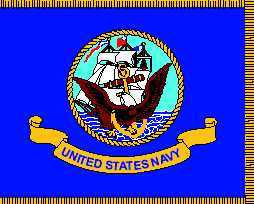U.S. NAVY FLAG
On 24 April 1959, the President, on the
recommendation of the Secretary of the Navy,
established an official flag for the United States Navy.
That was done to fulfill a need for an official flag to
represent the Navy in displays and on a variety of
occasions, such as ceremonies and parades. Figure 4-19
shows the Navy flag.
The U.S. Navy flag represents the Navy as follows:
At official ceremonies
In parades
In displays during official Navy occasions
At public gatherings when the Navy is an official
participant
On other occasions as may be authorized by the
Secretary of the Navy
When used for the purposes listed above, the Navy
flag accompanies, and takes the place of honor after, the
national flag. However, when other branches of the
armed forces are participating, the flags take precedence
in the order of seniority of the services represented.
PERSONAL FLAGS AND PENNANTS
Every Navy ship in commission flies the
commission pennant except when it is replaced by a
personal flag, command pennant, or Red Cross flag. The
commission pennant, shown in figure 4-20, is flown at
the after truck of a naval vessel and at the highest and
most conspicuous point of hoist on a fixed mastless ship
(submarines in particular). It is also flown from the bow
of a boat when a commanding officer, not entitled to a
personal flag, is embarked on an official visit.
The commission pennant is not a personal flag, but
sometimes it is regarded as the personal symbol of the
commanding officer. Along with the ensign and union
jack, it is half-masted upon the death of the
commanding officer of a ship.
The Red Cross (Geneva Convention) flag, shown in
figure 4-21, is the distinctive mark flown from the after
truck of a commissioned hospital ship of the Navy. In
general, the Red Cross flag is regarded as an
international guarantee of amnesty from attack. None of
the military services, however, fly it on the same halyard
as the national ensign. Boats engaged in sanitary service
and landing party hospital boats display the Red Cross
flag in the bow.
Some nations in the Middle East regard the cross as
a symbol contrary to their religious beliefs. Therefore,
they use a design such as a red crescent on a white field
or a red lion and sun on a white field to indicate a
mission of mercy or amnesty from attack.
No flag or pennant may be flown above or, if on the
same level, to the right of our national flag. One
exception is the display of flags at the United Nations
headquarters, where special rules apply. The only other
4-23
BMRF0419
Figure 4-19.—U.S. Navy flag.
BMRF0420
Figure 4-20.—Commission pennant.
BMRF0421
Figure 4-21.—Red Cross flag.
Student Notes:







